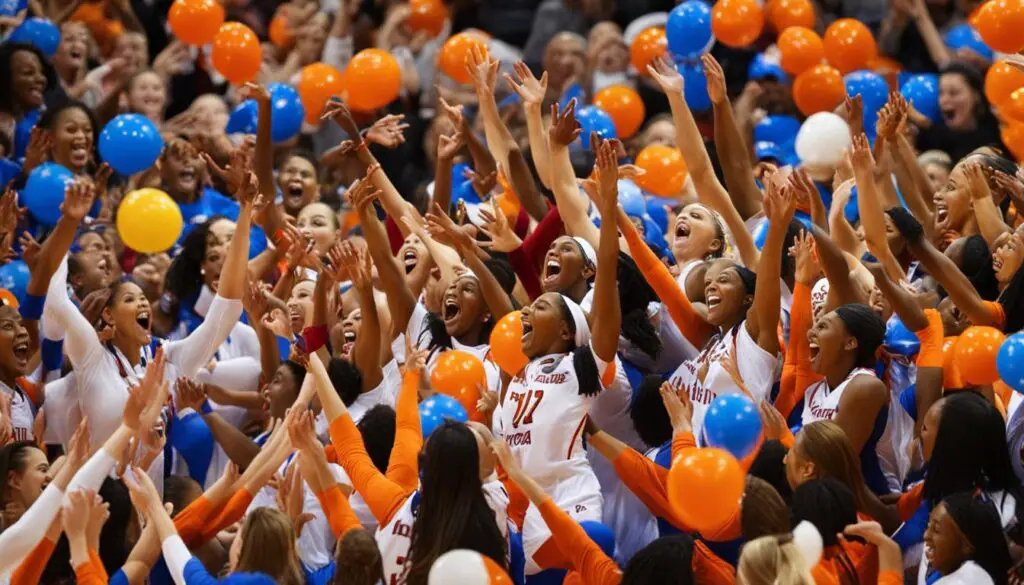The NCAA Women’s Basketball Rules Committee has recently approved a significant rule change in women’s college basketball game format. The traditional two 20-minute halves will now be replaced with four 10-minute quarters. This modification aims to enhance the flow of the game and make it more exciting for players and fans alike. Additionally, the transition to quarters brings some new regulations that add strategic elements to the game.
Key Takeaways:
- The NCAA Women’s Basketball Rules Committee has introduced a new game format in women’s college basketball, transitioning from two halves to four quarters.
- Teams will reach the bonus and shoot two free throws on the fifth team foul in each quarter, while team fouls will reset to zero at the start of each new quarter.
- The change is aimed at enhancing the game’s flow, increasing scoring opportunities, and adding strategic elements.
- Men’s college basketball still plays in halves, with team fouls reaching a bonus on the seventh and tenth fouls.
- The transition to quarters has not significantly impacted the length of the game or the number of fouls and free throws.
Reasons behind the change
The transition from halves to quarters in women’s college basketball was motivated by several reasons, all aimed at enhancing the game experience for players and spectators alike.
The first reason is to improve the flow of the game. In the previous format, after a basket was made, teams had to inbound the ball from the baseline and travel the entire length of the court to score. The four-quarter format eliminates this, allowing for quicker transitions and more scoring opportunities.
Another benefit of the new format is the reset of team fouls at the start of each quarter. This introduces strategic elements to the game, as teams have a fresh opportunity to reach the bonus and shoot two free throws on the fifth team foul in each quarter.
| Reasons behind the change | Benefits of quarters in women’s college basketball |
|---|---|
| Enhanced flow of the game | Allows for more scoring opportunities |
| Reset of team fouls at the start of each quarter | Introduces strategic elements |
The recommendation to transition to quarters in women’s college basketball was endorsed by the Women’s Basketball Coaches Association Board of Directors, signifying its support and recognition of the positive impact it would have on the game.
Next, let’s explore the differences between men’s and women’s college basketball in section 3.
Differences between Men’s and Women’s College Basketball
When it comes to college basketball, there are notable differences between the men’s and women’s game. One of the key variations is the game structure itself. Women’s college basketball has transitioned to playing in quarters, whereas men’s college basketball continues to play in halves. This fundamental difference has implications for how team fouls are processed and the opportunities for free throws.
In the four-quarter format of women’s college basketball, team fouls reset to zero at the end of each quarter. This reset allows teams to reach the bonus and shoot two free throws on the fifth team foul. This offers more chances for teams to capitalize on fouls committed by the opposing team. Conversely, in men’s college basketball, a team reaches a one-and-one bonus on the seventh team foul of each half and a two-shot bonus on the 10th team foul. The distinction in how team fouls are handled adds an additional strategic dimension to the game.
To visually showcase the differences between men’s and women’s college basketball, here is a table comparing the game structure variations:
| Women’s College Basketball | Men’s College Basketball | |
|---|---|---|
| Game Format | Quarters | Halves |
| Team Fouls Reset | At the end of each quarter | Not reset at halftime |
| Bonus Free Throws | Shoot two free throws on the fifth team foul in each quarter | Reach the one-and-one bonus on the seventh team foul of each half and the two-shot bonus on the 10th team foul |
It’s important to note these structural differences as they impact the flow and strategy of the game. Women’s college basketball’s transition to quarters has brought unique aspects that distinguish it from the men’s game, offering players and fans an exciting and engaging experience.

Impact on game length and scoring
Moving to the four-quarter format in women’s college basketball has had a notable impact on the game, particularly in terms of scoring opportunities. While the transition has not significantly changed the average number of fouls and free throws per game, it has brought about several positive changes that enhance the overall excitement of women’s college basketball.
Statistics from the 2014-2017 seasons show that the length of the game itself has not been significantly affected by the shift to quarters. The average duration of women’s college basketball games has remained relatively consistent, indicating that the introduction of quarters has not added substantial time to the overall gameplay.
However, one of the notable effects of the four-quarter format is the increase in scoring opportunities. With teams now advancing the ball closer to the scoring end of the court after inbounding, they can initiate offensive plays more efficiently. This change has resulted in a higher number of offensive possessions and, consequently, an uptick in scoring in women’s college basketball.
Moreover, the reset of team fouls at the start of each quarter plays a role in the game’s impact on scoring. By resetting the team fouls, it allows teams to reach the bonus and shoot two free throws on the fifth team foul in each quarter. This not only incentivizes aggressive play but also provides more scoring opportunities from the free-throw line.
To illustrate the impact, here is a comparison of the average points scored per game in women’s college basketball before and after the transition to quarters:
| Season | Points per Game (Pre-Quarters) | Points per Game (Post-Quarters) |
|---|---|---|
| 2013-2014 | 62.8 | 63.2 |
| 2014-2015 | 63.4 | 64.7 |
| 2015-2016 | 64.1 | 65.5 |
| 2016-2017 | 63.7 | 65.2 |
As indicated by these statistics, the transition to quarters has resulted in a consistent increase in scoring, highlighting the positive impact on the game.
Other Rule Changes and Improvements
Along with the transition to quarters, there have been additional rule changes in women’s college basketball that aim to enhance the game flow, offensive possessions, and overall enjoyment for both players and spectators.
One notable change is allowing teams to advance the ball to the frontcourt following a timeout after a made basket. This modification not only speeds up the game but also provides teams with more opportunities to strategize and set up plays.
Furthermore, exceptions to the 10-second backcourt rule have been implemented, allowing teams more time to bring the ball past half-court. This change promotes smoother transitions and reduces turnovers, contributing to a more engaging and dynamic playing experience.
Additionally, women’s college basketball now permits bands or amplified music during dead-ball situations, enhancing the fan experience and creating a more energetic atmosphere in the arenas. This change adds to the overall excitement of the game, creating a vibrant and engaging environment for players, coaches, and spectators alike.

Conclusion
In summary, the transition to four quarters in women’s college basketball has revolutionized the game, offering numerous benefits and improvements. One of the key advantages is the enhanced game flow. With shorter quarters, teams can capitalize on scoring opportunities more frequently, making the game more fast-paced and exciting.
Moreover, the reset of team fouls at the start of each quarter adds a strategic element to the game. It allows teams to strategize their fouls and maximize their chances of reaching the bonus and shooting free throws. This change has not only made the game more strategic but has also resulted in increased scoring and a higher free throw percentage.
Overall, the switch to quarters has been a positive move for women’s college basketball. The four-quarter format has not only improved the flow and pace of the game but has also added excitement and strategic elements. With the implementation of other rule changes alongside the transition, the game experience has been elevated for players and fans alike. Women’s college basketball continues to evolve, and these changes contribute to its continued growth and popularity.
FAQ
Why do women’s college basketball play quarters?
The transition to four quarters in women’s college basketball was recommended to enhance the flow of the game and increase scoring opportunities.
What are the benefits of quarters in women’s college basketball?
The four-quarter format allows for more scoring opportunities and strategic elements, while also improving game flow and overall excitement.
What are the differences between men’s and women’s college basketball?
In women’s college basketball, team fouls reset to zero at the start of each quarter, and teams shoot two free throws on the fifth team foul. In men’s college basketball, team fouls accumulate throughout each half, with different bonus rules.
How have quarters affected the length and scoring in women’s college basketball?
The switch to quarters has not significantly changed the average number of fouls and free throws per game or the length of the game. However, it has allowed for more scoring opportunities and a higher free throw percentage.
Have there been any other rule changes in women’s college basketball?
Yes, along with the transition to quarters, other rule changes include allowing teams to advance the ball to the frontcourt after a timeout following a made basket, exceptions to the 10-second backcourt rule, and enhanced fan experiences during dead-ball situations.
What are the positive changes brought about by the transition to quarters in women’s college basketball?
The switch to four quarters has enhanced game flow, increased scoring opportunities, improved strategic elements, and overall enjoyment for players and fans.
Source Links
- https://www.sportingnews.com/us/ncaa-basketball/news/ncaa-womens-basketball-quarters-halves/mhw1cdc5tgbsznjglsesixwo
- https://www.ncaa.org/news/2015/6/8/women-s-basketball-moves-to-a-four-quarter-format.aspx
- https://www.lcsun-news.com/story/sports/college/NMSU/2015/06/08/college-basketball-womens-basketball-going-four-10-minute/32298601/
